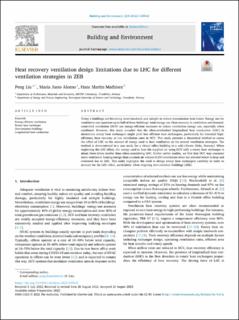| dc.contributor.author | Liu, Peng | |
| dc.contributor.author | Justo Alonso, Maria | |
| dc.contributor.author | Mathisen, Hans Martin | |
| dc.date.accessioned | 2022-09-21T08:26:04Z | |
| dc.date.available | 2022-09-21T08:26:04Z | |
| dc.date.created | 2022-09-09T21:24:28Z | |
| dc.date.issued | 2022 | |
| dc.identifier.citation | Building and Environment. 2022, 224 . | en_US |
| dc.identifier.issn | 0360-1323 | |
| dc.identifier.uri | https://hdl.handle.net/11250/3020112 | |
| dc.description.abstract | Today's buildings are becoming more insulated and airtight to reduce transmission heat losses. Energy use for ventilation can represent up to half of these buildings' total energy use. Heat recovery in ventilation and demand-controlled ventilation (DCV) are energy-efficient measures to reduce ventilation energy use, especially when combined. However, this study revealed that the often-overlooked longitudinal heat conduction (LHC) in aluminium rotary heat exchangers might yield less efficient heat exchangers, particularly for intended high-efficiency heat recovery at low ventilation rates in DCV. This study presents a theoretical method to assess the effect of LHC on the amount of energy used to heat ventilation air for several ventilation strategies. The method is demonstrated in a case study for a virtual office building in a cold climate (Oslo, Norway). When neglecting the LHC effect, the energy used to heat the supplied air using DCV with a rotary heat exchanger is about three times smaller than when considering LHC. Unlike earlier studies, we find that DCV may consume more ventilation heating energy than constant air volume (CAV) ventilation when the selected wheel is deep and oversized due to LHC. This study highlights the need to design rotary heat exchangers carefully in order to account for the LHC effect, particularly when targeting zero emission buildings (ZEB). | en_US |
| dc.language.iso | eng | en_US |
| dc.publisher | Elsevier | en_US |
| dc.rights | CC BY 4.0 | * |
| dc.rights.uri | http://creativecommons.org/licenses/by/4.0/ | * |
| dc.subject | Energy-efficient ventilation | en_US |
| dc.subject | Rotary heat exchanger | en_US |
| dc.subject | Zero-emission buildings | en_US |
| dc.subject | Longitudinal heat conduction | en_US |
| dc.title | Heat recovery ventilation design limitations due to LHC for different ventilation strategies in ZEB | en_US |
| dc.title.alternative | Heat recovery ventilation design limitations due to LHC for different ventilation strategies in ZEB | en_US |
| dc.type | Peer reviewed | en_US |
| dc.type | Journal article | en_US |
| dc.description.version | publishedVersion | en_US |
| dc.rights.holder | © 2022 The authors | en_US |
| dc.subject.nsi | VDP::Teknologi: 500 | en_US |
| dc.source.pagenumber | 10 | en_US |
| dc.source.volume | 224 | en_US |
| dc.source.journal | Building and Environment | en_US |
| dc.identifier.doi | 10.1016/j.buildenv.2022.109542 | |
| dc.identifier.cristin | 2050441 | |
| dc.relation.project | Norges forskningsråd: 257660 | en_US |
| cristin.ispublished | true | |
| cristin.fulltext | original | |
| cristin.qualitycode | 2 | |

